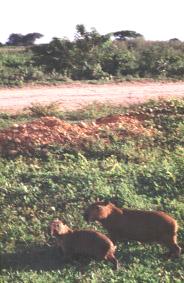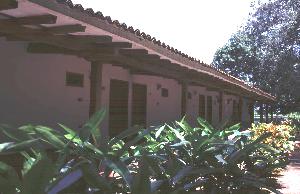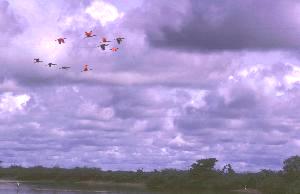|
PLAINS, MANES AND AUTOMOBILES
Some paragraphs extracted
from the Traveler's Venezuela Companion © The Globe Pequot Press.
Reproduced with permission.
 A land of infinite
skies. A land of infinite
skies.
Unbending plains that stretch the imagination, where mirages massage
horizons with their heat-haze fingers, and clusters of cumulus clouds,
their puffy shapes echoed by the military green of the gallery forests
below, carpet the sky above the flat lands.
A family of comic, rectangular-muzzled capybaras lounges near the
road, occasionally sloping into a nearby stream to cool off. Flocks
of egrets, ibis and heron swoop over the waters, eyeing their prey.
Furtive, buff-coloured deer spring away from the road. On sandy
banks, next to muddied turtles, spectacled caymans slouch, mouths
agape, teeth glinting "all the better to eat you with, my dear".
So these are Los Llanos, The Plains.
Llanero cowboys, "indomitable and long-suffering" and
tough as old boots, herd thousands of head of cattle from pasture
to market. Like the cowboys of Stage Coach or the gauchos
of Argentina, they have assumed mythical proportions, central to
the country's identity and historical heritage. Often barefooted,
they break wild horses, and sing laments to comfort their lonely
souls. Four-string ukulele-like instruments (cuatros),
maracas and small harps accompany their cris-de-coeur. The tunes
of the llanero have become Venezuela's national music, while the
song, Alma Llanera, is the country's unofficial national anthem
- and a lot prettier.
Don Ramon, with his flattened-feature face always about to burst
into a smile for his 39 grandchildren, manoeuvres through the hyacinth-choked
waterways. A caracara hawk screeches alarm as kingfishers dive-bomb
the boat. Cormorants fumble ineptly into the air as the craft approaches.
Piranhas happy snap at meat bait dangled from fishing rods. Get
your fingers sliced in 24 seconds.
The sun beats an unrelenting rhythm on the landscape's pistachio
skin. Hundreds of horses and herds of cattle graze for mile upon
mile. Above, flocks of storks and heron arrow their way across the
blue and white skies. From its lookout in the bough of a tree, a
maguire stork stands to attention over its nest, its long white
neck an iridescent arc in the searing light.
STAGECOACH

Carlito, the diminutive black-wellied waiter of the Hato
Cedral (Cedral Ranch), attempts to assert his manhood in this land
of cowboys, steaks and hats by the gallon. I reckon, when he goes
to town, he lies about his job description. Hanging out in the kitchen
with the women is hardly the stuff of Stagecoach.
Storms brew ever-more menacing shades of grey in the distance. The
rains have come at last. As clouds mass, the breeze picks up and
the bird calls become more urgent. After a few curtain-raiser drops,
the main act begins. The frogs have been waiting months for this
moment. They chirp and burble their joy in a giant amphibian fanfare.
When the rains finally stop, it sounds like the land's beating heart
has been brought to life.
On the map, the blue lines form a giant spaghetti funnel, thickening
as they flow east from the Andean peaks. At the funnel's mouth,
the mighty Orinoco.
 The Plains are a land of two seasons. In the dry months from
November, water holes wither away to puddles, stranding fish which
flip-flap helplessly. Rivers are shrink-wrapped by the incessant
heat, while mighty anacondas die dusty deaths in mud coffins. Dust
clouds swirl in the winds, sculpting dunes twenty feet high. Animals
throng the few remaining water sources, until, finally, in May,
the rains begin at last. By July, swathes of savannah are transformed
into marsh and lake, flooding huge expanses. Droves of breeding
birds of every description congregate to fish in the fertile waters. The Plains are a land of two seasons. In the dry months from
November, water holes wither away to puddles, stranding fish which
flip-flap helplessly. Rivers are shrink-wrapped by the incessant
heat, while mighty anacondas die dusty deaths in mud coffins. Dust
clouds swirl in the winds, sculpting dunes twenty feet high. Animals
throng the few remaining water sources, until, finally, in May,
the rains begin at last. By July, swathes of savannah are transformed
into marsh and lake, flooding huge expanses. Droves of breeding
birds of every description congregate to fish in the fertile waters.
After lunch, a cowboy sits under the shade of a tree, his chair
lent back against the trunk, his starched-white hat tilted down
over his tan brown brow. He's reading People magazine.
 The ranch banned hunting
years ago. Slowly but surely the wildlife came back. There are now
over twenty thousand capybaras, the largest -- and possibly most
endearing -- rodent of all, and a few Orinoco crocodiles survive
of the seven million exterminated earlier this century. Water courses
are damned and sluiced, to maintain the thirty thousand head of
cattle that keep the farm going, and roads criss-cross the countyside
with Roman rigidity. In other parts of the Plains, capybaras are
hard to spot. Here they're so docile they almost get run over. They're
tasty too. Capyburgers, yum. The ranch banned hunting
years ago. Slowly but surely the wildlife came back. There are now
over twenty thousand capybaras, the largest -- and possibly most
endearing -- rodent of all, and a few Orinoco crocodiles survive
of the seven million exterminated earlier this century. Water courses
are damned and sluiced, to maintain the thirty thousand head of
cattle that keep the farm going, and roads criss-cross the countyside
with Roman rigidity. In other parts of the Plains, capybaras are
hard to spot. Here they're so docile they almost get run over. They're
tasty too. Capyburgers, yum.
We landed in the eye of a torrential rainstorm. I couldn't see a
runway, only pasture. I spotted some people herding capybaras to
one side. Then I understood. Landing gave a whole new meaning to
grass stains...
 This tour
can be booked through Alpi Tour, one of Venezuela’s foremost,
and most experienced tour operators and travel agents. Contact tel
+58 212 283-1433 fax (0212) 285-6067, in the USA (520) 447-7959
email: alpitour@viptel.com web: www.alpi-group.com
. Bob Sonderman puts together first-class flying safaris to the
wilds of Venezuela. This tour
can be booked through Alpi Tour, one of Venezuela’s foremost,
and most experienced tour operators and travel agents. Contact tel
+58 212 283-1433 fax (0212) 285-6067, in the USA (520) 447-7959
email: alpitour@viptel.com web: www.alpi-group.com
. Bob Sonderman puts together first-class flying safaris to the
wilds of Venezuela.
|







 The Plains are a land of two seasons. In the dry months from
November, water holes wither away to puddles, stranding fish which
flip-flap helplessly. Rivers are shrink-wrapped by the incessant
heat, while mighty anacondas die dusty deaths in mud coffins. Dust
clouds swirl in the winds, sculpting dunes twenty feet high. Animals
throng the few remaining water sources, until, finally, in May,
the rains begin at last. By July, swathes of savannah are transformed
into marsh and lake, flooding huge expanses. Droves of breeding
birds of every description congregate to fish in the fertile waters.
The Plains are a land of two seasons. In the dry months from
November, water holes wither away to puddles, stranding fish which
flip-flap helplessly. Rivers are shrink-wrapped by the incessant
heat, while mighty anacondas die dusty deaths in mud coffins. Dust
clouds swirl in the winds, sculpting dunes twenty feet high. Animals
throng the few remaining water sources, until, finally, in May,
the rains begin at last. By July, swathes of savannah are transformed
into marsh and lake, flooding huge expanses. Droves of breeding
birds of every description congregate to fish in the fertile waters.
 The ranch banned hunting
years ago. Slowly but surely the wildlife came back. There are now
over twenty thousand capybaras, the largest -- and possibly most
endearing -- rodent of all, and a few Orinoco crocodiles survive
of the seven million exterminated earlier this century. Water courses
are damned and sluiced, to maintain the thirty thousand head of
cattle that keep the farm going, and roads criss-cross the countyside
with Roman rigidity. In other parts of the Plains, capybaras are
hard to spot. Here they're so docile they almost get run over. They're
tasty too. Capyburgers, yum.
The ranch banned hunting
years ago. Slowly but surely the wildlife came back. There are now
over twenty thousand capybaras, the largest -- and possibly most
endearing -- rodent of all, and a few Orinoco crocodiles survive
of the seven million exterminated earlier this century. Water courses
are damned and sluiced, to maintain the thirty thousand head of
cattle that keep the farm going, and roads criss-cross the countyside
with Roman rigidity. In other parts of the Plains, capybaras are
hard to spot. Here they're so docile they almost get run over. They're
tasty too. Capyburgers, yum.